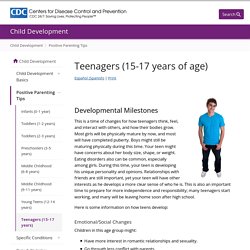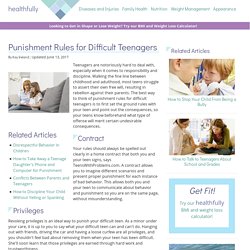Zoom
Trash

Ages & Stages Of Child Development. Teen Development: MedlinePlus. Adolescence (15-17 years old) CDC’s Adolescent and School Mental Health Learn how connection is key to good adolescent mental health.

CDC’s Parent Information (Teens 12— 19) This site has information to help you learn how to guide your teen to be safe and become a healthy and productive adult. CDC’s Healthy Weight Information. Tips for parents – Ideas to help children maintain a healthy weight. CDC’s Youth Physical Activity Guidelines This site has information on how to help children be active and play. CDC’s Pregnancy Prevention for Teens. Reinforcement and Punishment. Learning Objectives Explain the difference between reinforcement and punishment (including positive and negative reinforcement and positive and negative punishment)Define shapingDifferentiate between primary and secondary reinforcers In discussing operant conditioning, we use several everyday words—positive, negative, reinforcement, and punishment—in a specialized manner.

In operant conditioning, positive and negative do not mean good and bad. Instead, positive means you are adding something, and negative means you are taking something away. Reinforcement means you are increasing a behavior, and punishment means you are decreasing a behavior. Page 7: Negative Consequences. Page 7: Negative Consequences Teachers can use negative consequences to reduce instances of noncompliance.

When they develop their classroom behavior management plans, teachers should create a negative consequence hierarchy that ranges from the least-intrusive (e.g., rule reminder) to the most-intrusive consequence (e.g., parent contact, office referral). When a student engages in inappropriate behavior, the teacher should begin by administering the least-intrusive consequence. If the student continues to misbehave, the teacher should administer increasingly intrusive consequences until the misbehavior stops. For students who frequently engage in inappropriate or disruptive behavior (i.e., repeat offenders) or commit a major rule violation (e.g., fighting), the teacher might skip the least-intrusive consequences and administer more-intrusive ones. Page 6: Positive Consequences. Page 6: Positive Consequences Once they’ve developed their rules and procedures, teachers must take action either to recognize or to correct student behavior.

Such actions are referred to as consequences. Effective consequences preserve the student’s dignity and increase his or her motivation to behave appropriately. Like rules, they should be age-appropriate. How to Properly Use Reinforcement and Punishment - North Shore Pediatric Therapy. Teens May Learn Best with Positive Reinforcement. A new study finds that adolescents focus on rewards and are less able to learn to avoid punishment or consider the consequences of alternative actions.

University College-London investigators compared how adolescents and adults learn to make choices based on the available information. Investigators tracked the way in which 18 volunteers aged 12-17 and 20 volunteers aged 18-32 completed tasks in which they had to choose between abstract symbols. Each symbol was consistently associated with a fixed chance of a reward, punishment, or no outcome. Positive Reinforcement in Teenagers. Teenagers might need special incentives to learn skills, develop responsibility and make positive decisions about their conduct.

One effective way to encourage the behaviors you want is to use the behavior management technique of positive reinforcement. Through positive reinforcement, you gradually make it more likely that your teenager will demonstrate the desired behaviors. Goals of Positive Reinforcement The beauty of positive reinforcement is that it teaches and motivates specific behaviors by using items or activities that appeal to your teenager, states Shannon Baranski, psychology professor with the Houston Community College. Instead of punishing your adolescent by taking away an item or a privilege, you harness the psychological power of a powerful incentive to encourage him to cooperate or perform.
Rewarding behavior is key to parenting teens, study suggests. Parenting is hard, and parenting teens brings about an entirely new set of challenges, from keeping their rooms clean to getting them home before curfew.

But, a new study suggests parents who want their teenagers to keep their grades up could have better success if they focus more on rewarding good behavior and less on threatening to punish the bad. According to the report, published in PLOS Computational Biology, British researchers have found that adolescents focus well on positive incentives, but have difficulty staying motivated to avoid penalties. The study shows that teens and adults learn in different ways, according to the study’s lead author Stefano Palminteri, a researcher with the Institute of Cognitive Neuroscience at University College London. It suggests that “in some cases positive feedback may have more of an effect than negative feedback on learning” in adolescents. Punishment Rules for Difficult Teenagers.
Teenagers are notoriously hard to deal with, especially when it comes to responsibility and discipline.

Walking the fine line between childhood and adulthood, most teens struggle to assert their own free will, resulting in rebellion against their parents. The best way to think of punishment rules for difficult teenagers is to first set the ground rules with your teen and point out the consequences, so your teens know beforehand what type of offense will merit certain undesirable consequences. Contract Your rules should always be spelled out clearly in a home contract that both you and your teen signs, says TeensWithProblems.com. When Should You Take the Phone Away from a Teenager? Kate Gosselin, the mom in the reality series Kate Plus 8, isn’t exactly someone we’d turn to for inspirational parenting.

But she recently said something on a television special that caught our attention. Speaking of her two 13-year-old daughters, she tells the camera: “I got those girls cell phones and iPads so that I could take them away.” Gosselin makes the move sound especially manipulative, but in fact taking away “screen time,” or access to electronic devices, has become a parent’s go-to consequence for unacceptable behavior at practically every age, from toddlers to teens. And if you’re talking about teens, there’s an added dimension. As Gosselin puts it rather crudely, “You get their attention because you cut them off from their friends.” For teens, the threat of having their phone confiscated or, worse, having their phone searched by their parents, would seem to be a powerful deterrent to bad behavior.
Social media replaces the mall Related Video: How much is too much? Effective Vs. Counterproductive Methods Of Teen Punishment. Updated September 17, 2018 Reviewer Tiffany Howard, LPC, LCADC Source: pinterest.com In the current day and age, parental knowledge regarding effective and counterproductive methods of setting limits and consequences for their teens is paramount.

However, a clear understanding is often easier said than obtained.